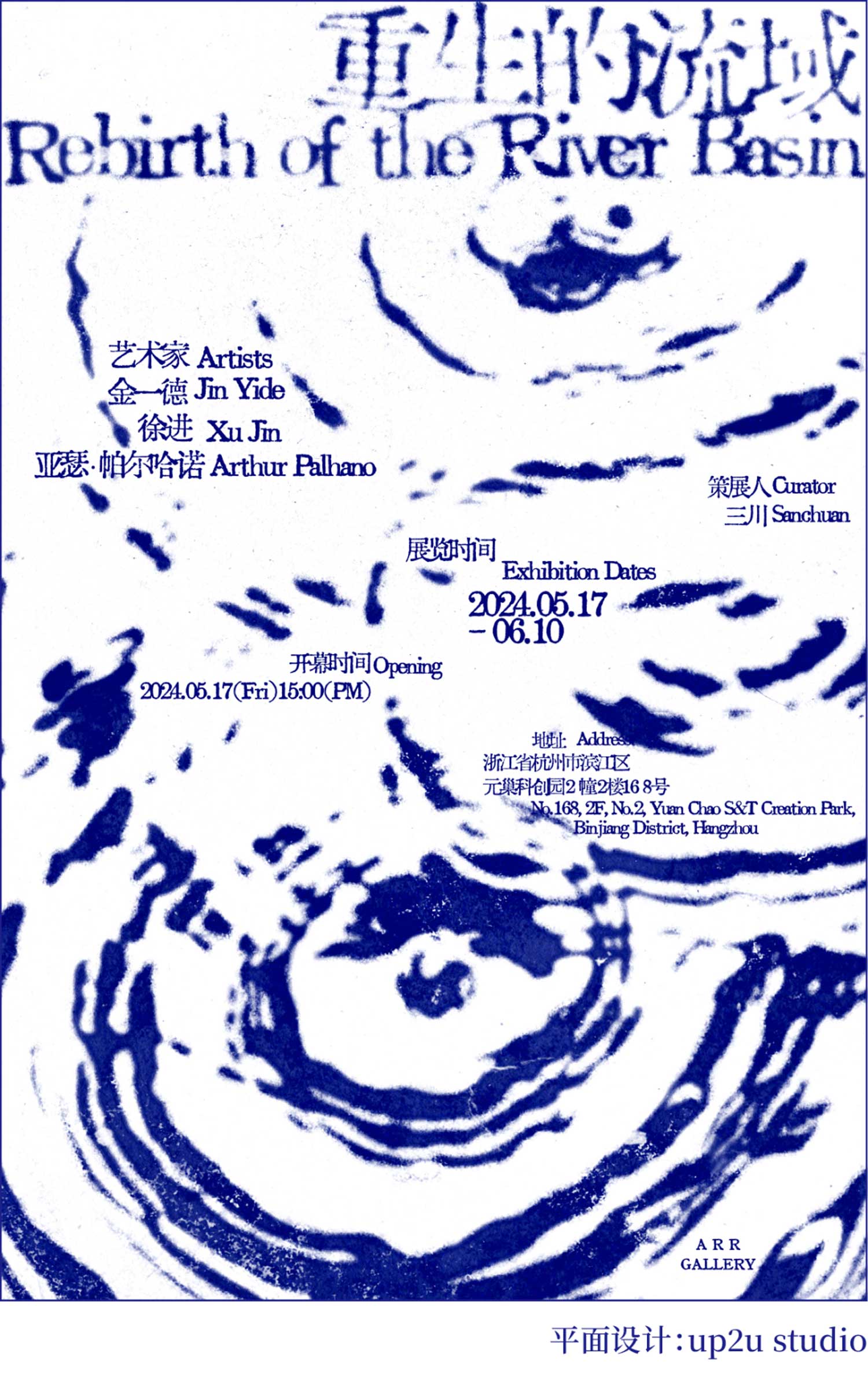展期 Period:
2024.5.17—2024.6.10
艺术家 Artist:
金一德 Jin Yide、徐进 Xu Jin、亚瑟·帕尔哈诺 Arthur Palhano
策展人 Curator:
地点 Venue:
前言 Introduction:
本次展览将呈现金一德、徐进、Arthur Palhano(巴西)三位艺术家的作品。展览将向我们揭示一种自觉的复杂性,复杂来自于他们的工作身处现代进程之中,又要在自我剖视的视角中停留,这一暂停的时刻会在工作持续的时间流中撬开绘画的门缝,艺术家忍受不住窥视冲动,总要将视线投向其中,并承受随之而来的震颤与沉默。
三位艺术家携带着三种时代的目光,这些目光在流向别处之前,此刻正经过他们自身。金一德先生时常于工作室中向来访者追问对于他近作的意见,并诚切等待一个能将之“来路”彻底击碎的回答,同时在自己的绘画中确凿而坚韧地由内向外开垦,像一位修行者恒常的日课,不停埋下双重的伏笔,等待它们终将双向的洞穿自身,好在工作的内部重新孕育出一个艺术发生的时刻。而常年往返于中外的艺术家徐进,更像一位居于旅途之人,迁徙和多年异域生活的经验也在他的作品中显露痕迹。徐进认领这一动态的命运,命运也反馈艺术家以独属于他的特殊之能。这是作为观察者的“远视之眼”,这种“距离感”盘踞在他生命经验的时空中,使得艺术家在执笔时,能够从容的从“远”中探囊取物,从而逃离某种确定性的贫乏。由此肉身在东西半球间的移动也成为徐进工作方式中重要的节奏型,主动游走在地缘的交锋之处并与之共振,重构出新的可用作自我定位的注脚。令人惊叹的是,徐进最近在杭州的工作室中,又暂时搁置了这一自如的工作方式(调用记忆与图像作为媒材),艺术家反置画布,主动设置笔速的障碍,徐而向内行进,这或许是正在被书写和建立中的情感,于此刻是难以言说的。
金一德先生与徐进在艺术上亦师亦友,工作室也同在杭州滨江,出生自里约热内卢(现居圣保罗)的 Arthur Palhano 作为展览中最年轻的艺术家由南美洲远道而来。他从 2020 年开始使用“珐琅漆”(enamel,一种在巴西被广泛使用的建筑涂料),将这一常见于贫民窟的材料和油画颜料并置在一起混合使用。Palhano 对于其工作的自觉性是前置化的,他无时不刻用警惕的目光收集这些包裹着他故乡的图像:骷髅、心形图案、宗教符号与乐队 logo,以及经过了二十世纪依然存留在各处的广告图像史,并注视(或者说是审视)它们至今如此紧密纠缠在一起的成因。艺术家在此像一位年轻的侦探,要将自身也作为生养他的地缘中的某种顽固标记来破除这些来自历史动因中复数图层的裹挟(同样也显化为艺术家处理绘画的技术手段)。他喜爱学校中课桌椅上和墙壁表面随处可见的破坏性涂鸦和刻痕,它们对于 Palhano 而言,意味着个体对学校这种塑造自我的空间进行的首次小小反抗,更重要的是当艺术家还身处其中之时。Palhano 在其中召回的也不仅仅是被再现(representation)的图像,而是藏在了土地与血缘中的记忆原貌。
人不能两次迈入同样的河流,但在另一种意义上,在河流中驻足的观察者,或许会在此刻的流动中瞥见它所从属的流域,由此将自己置入更大的时空感与可能性之中。三位艺术家的目光通过作品的在场于此地交集,唯有自觉者会选择更难的路径,也唯有这一种经过了自身再向外投射的目光,能够在无常的世界中对焦出另一种真实的瞬间。
This exhibition will present works by three artists: Jin Yide, Xu Jin, and Arthur Palhano from Brazil. The exhibition will reveal a conscious complexity, arising from their works being situated within the modern process while also pausing within the perspective of self-examination. This momentary pause will pry open the door of painting within the continuous flow of time, as artists cannot resist the impulse to peer within and endure the subsequent tremors and silence.
The gaze of these three artists carries the perspectives of three eras, which, before flowing elsewhere, are currently passing through themselves. Mr. Jin Yide often asks visitors to his studio for opinions on his recent works, earnestly awaiting a response that can thoroughly shatter their "origin," while steadfastly cultivating his painting from within to without, like a practitioner's daily ritual, continuously laying down dual foreshadowings, waiting for them to pierce through themselves bidirectionally, thus nurturing a moment of artistic occurrence within the inner workings of the work. Meanwhile, the artist Xu Jin, who shuttles between China and abroad, resembles a person living in transit, with traces of migration and years of life in foreign lands evident in his works. Xu Jin accepts this dynamic fate, and in return, fate endows the artist with a special ability uniquely his own. It's akin to the "foresight eyes" of an observer, this "sense of distance" lingering in the spacetime of his life experience, allowing the artist to calmly extract from the "distant" while wielding his brush, thereby escaping a certain poverty of certainty. Thus, the movement of the body between the Eastern and Western hemispheres becomes an important rhythmic element in Xu Jin's working method, actively wandering at the crossroads of geopolitics and resonating with it, reconstructing new footholds that can be used for self-positioning. It is astonishing that Xu Jin, recently in his studio in Hangzhou, temporarily set aside this freely way of working (using memory and images as materials). He reversed the canvas, actively obstructed the speed of the brush, and gradually moved inward. Perhaps this is the emotion being written and established, which is difficult to articulate at this moment.
Mr. Jin Yide and Xu Jin are both mentors and friends in art, and their studios are both located in Binjiang, Hangzhou. Arthur Palhano, born in Rio de Janeiro (now living in São Paulo), came all the way from South America as the youngest artist in the exhibition. Since 2020, he has been using "enamel" (a type of building paint widely used in Brazil), mixing this material commonly found in slums with oil paint. Palhano's self-awareness about his work is preemptive; he constantly collects images wrapped around his hometown with a vigilant gaze: skeletons, heart-shaped pat-terns, religious symbols, band logos, and the history of advertising images that have survived throughout the twentieth century, observing (or rather, examining) the tightly entangled causes of these images. Like a young detective, the artist here aims to dismantle these multiple layers of historical causes, which are also manifested as the technical means of the artist's handling of painting. He enjoys the destructive graffiti and scratches found everywhere on school desks and walls, which for Palhano, signify the first small resistance of individuals to the space that shapes their identity, and more importantly, when the artist was still within it. What Palhano recalls is not just the reproduced images but also the original memories hidden in the land and bloodline.
One cannot step into the same river twice, but in another sense, the observer who pauses in the river's flow may glimpse the watershed to which it belongs at this moment, thereby placing themselves within a greater sense of time and possibility. The gazes of the three artists intersect here through the presence of their works, and only the conscious ones will choose the more difficult path. And only this kind of gaze, which has been projected outward from itself, can focus on another kind of true moment in the impermanent world.

